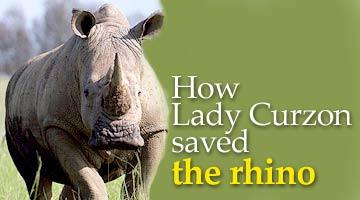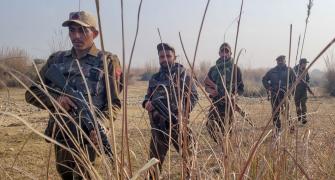
Most Indians may remember Lord George Curzon as the man who sowed the seeds for the Hindu-Muslim divide during his tenure as viceroy between 1898 and 1905.
But a hundred years later, one state has gone out of its way to erase that bitter memory by honouring Curzon's grandson for something that his wife Mary Leiter did -- speed up the process of reserving an area for a rhino sanctuary.
We are talking about Assam's Kaziranga nature reserve, India's biggest wildlife conservation success.
The Kaziranga Centenary celebrations kicked off in the state on February 11.
The five-day fete was marked by the presence of Curzon's grandson, Nicholas Moseley (Lord Ravensdale) and his wife Lady Verity.
The Ravensdales were the cynosure of all eyes at the countless functions they attended.
At the end of it all they were tired, but "moved beyond words by the hospitality and the wonderful people".
At one event, Lord Ravensdale was visibly moved when Chief Minister Tarun Gogoi walked towards him to present a memento. The Briton got up from his seat and ambled onto the dais with the help of walking sticks.
"I am honoured by the love and respect. I don't know what else to say, but thank you very much. My salute to all the people who have contributed to the Kaziranga success story," he said.
Lord Ravensdale has yet to fulfill a dream. "I am yet to see a rhino here. I had a bad fall just before our trip and I am not able to move around without a wheelchair. Despite my desire, I cannot get atop an elephant for a safari inside the park," he said.
Lady Verity, who did go on a safari and saw "five rhinos and plenty of deer," described the experience as "wonderful."
In London, the couple stays in a manor, built in 1840, close to Regent Park.
The real story of Kaziranga lies with persuasive local wildlife enthusiast Bapiram Hazarika, who was more popularly known as Nigona shikari.
Had it not been for his courage and conviction, the Kaziranga National Park, famous for its large concentration of the one-horned rhino, may not have come into existence at all.
According to Nitin A Gokhale and Samudra Gupta Kashyap, co-authors of the coffee table book Kaziranga: A Rhino Century, 'Although Lady Mary Leiter Curzon is often credited with having told her husband, Lord George Curzon, the Viceroy of British India, to take urgent steps to save the rhino, it was Nigona shikari who actually convinced Lady Curzon about the existence of the great one-horned Indian rhino in the forest that we today know as Kaziranaga National Park.'
The book was released by Lord Ravensdale in Kaziranga on February 13.
They write in the book: 'Kaziranga National Park, which completes 100 years of its existence in February 2005, is today regarded as one of the most stunning conservation success stories anywhere in the world. Its USP is the one-horned rhino, now numbering over 1,700 but the park also has a wider variety of flora and fauna not seen together elsewhere on this planet. The World Heritage Site tag that it has earned is therefore well-deserved but the origins of the Park are a story by itself.'
The story goes back to the first decade of the 20th century when tea gardens were springing up all over Assam. One such garden, Naharjan, was located close to the present-day Kaziranga National Park.
A gentleman called Forbes, who was perhaps a distant relative of Lady and Lord Curzon, managed this garden. He was an honorary magistrate of the area that was then called Nam-Doyang.
In January 1905, during a trip to Assam, Lady Curzon was interested in visiting the Naharjan tea estate since Forbes had told her tales about its rich fauna.
Forbes arranged for three elephants for Lady Curzon and her entourage to go around the area. He also called for Nigona shikari to accompany the distinguished visitor.
Forbes had several reasons to get Nigona shikari as a guide. Besides being a self-taught naturalist, and not a hunter as his nickname 'shikari' suggested, Nigona was also a very good mahout and knew the jungle inside out.
As the party set out for the wild from Forbes' bungalow, Nigona took charge as the mahout of the elephant that was carrying Lady Curzon.
Nigona did not know English, but that apparently was not a constraint as he set about explaining the finer points of the jungle to the VVIP wildlife enthusiast with Forbes acting as interpreter.
As they went deeper into the forest, Nigona spotted a rhino in the distance and excitedly pointed it out to Lady Curzon.
She, however, did not believe him and insisted that it was a wild buffalo.
'No, it is a rhino,' insisted Nigona. Forbes, who had full confidence in Nigona's knowledge of the area, ordered the elephants closer to the animal.
By the time the party arrived at the spot, the animal had disappeared into the thicket. This compounded Lady Curzon's disbelief.
Nigona would not be discouraged so easily. He brought the elephants to a halt, got down and inspected the undergrowth as Lady Curzon and Forbes watched fascinated.
Minutes later, Nigona beckoned the visitors to take a look at something. As they descended from the makeshift howdah, Nigona pointed out a series of fresh pugmarks that had three toes on each foot.
Convinced that she had indeed seen the rare sight of a rhino in the wild, Lady Curzon then asked Nigona many questions about rhinos and their habitat.
This was Nigona's chance to display his knowledge about the rhinos and air his concern about the indiscriminate killing of the rare animal by white hunters.
"How can we save this wonderful animal?" asked the lady.
Nigona had a simple solution. 'Stop the sahibs from killing them,' he told Lady Curzon.
Lady Curzon, on her return to Calcutta, pressed her all-powerful husband to issue orders that would prohibit the hunting of rhinos in Assam.
It took another six months for the government to issue a notification declaring an area of 57,273.60 acres of forest close to Naharjan as the Kaziranga Proposed Reserve Forest.
A hundred years later Kaziranga has become synonymous with Assam, and the one-horned rhino is the most recognisable symbol of the state.
The charging one-horned rhino is the official logo for many companies and corporations in the state.
It is seen on buses of the Assam State Transport Corporation and is the official mascot of the Assam Oil Company, later renamed the Assam Oil Division, a fully-owned subsidiary of petroleum giant Indian Oil Corporation.
More interestingly, it is visible as the crest on an Indian Air Force fighter squadron based at Tezpur not very far from Kaziranga.
Main image: Rahil Shaikh







